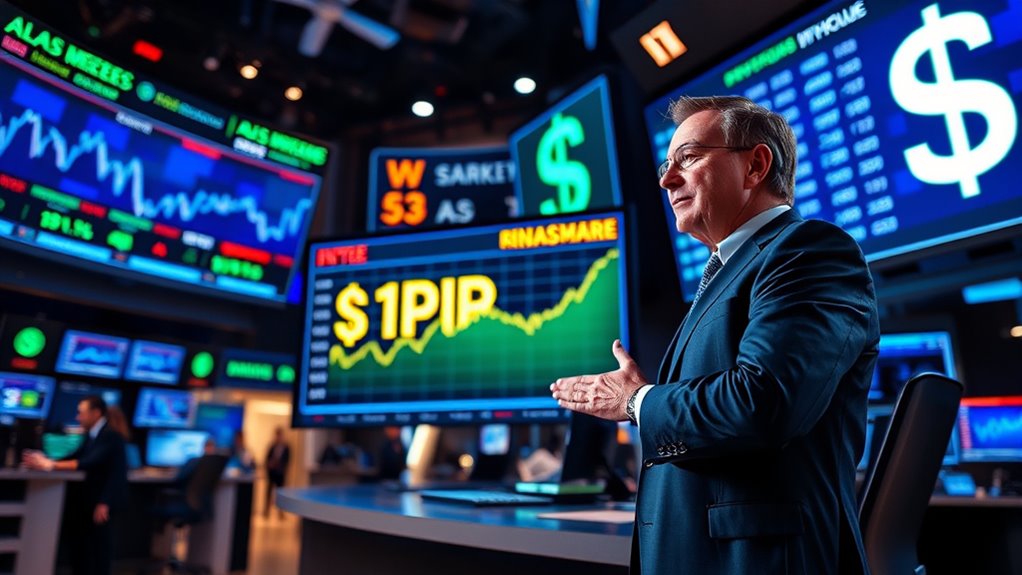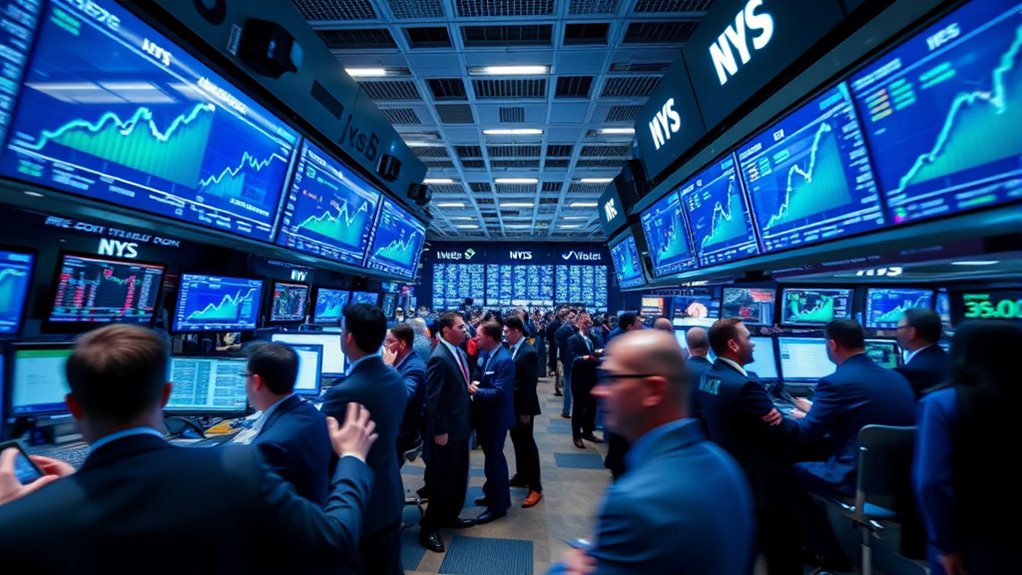The recent surge in the Producer Price Index (PPI), driven by tariff increases, is boosting the dollar as investors see rising inflation and expect tighter Federal Reserve policies. As wholesale prices climb, the dollar gains strength, reflecting confidence in economic resilience. This trend suggests inflation could stay elevated longer, prompting rate hikes. If you want to understand how tariffs and inflation are shaping the dollar’s strength, keep exploring the details behind this rally.
Key Takeaways
- The PPI surge signals rising inflation, prompting investors to favor the dollar as a safe-haven asset.
- Higher wholesale prices contribute to expectations of Federal Reserve rate hikes, strengthening the dollar.
- Tariff-driven inflation increases make the dollar more attractive due to its perceived resilience.
- Elevated inflation data boosts investor confidence in the dollar’s stability and growth prospects.
- The recent PPI increase underscores economic resilience, supporting the dollar’s position in currency markets.

A recent surge in the Producer Price Index (PPI) has boosted the U.S. dollar, signaling rising inflation pressures and influencing market expectations. In July, the PPI jumped by 0.9%, marking the largest monthly increase since June 2022. This sharp rise pushed the annual headline PPI inflation rate up to 3.3%, revised upward from previous estimates of around 2.3-2.4% in June. The core PPI, which excludes volatile food and energy prices, also rose 0.9% month-over-month and 3.7% year-over-year, surpassing forecasts and indicating broad-based inflationary momentum. The July surge followed a period of stagnation in June, where wholesale prices showed no notable change, highlighting a sudden resurgence of inflation that’s catching market attention. Notably, this is the most substantially wholesale price increase in over three years, signaling a notably inflationary event with widespread implications.
Much of this increase stems from tariffs impacting imported goods, which have driven up wholesale prices considerably. As tariffs rise, importers face higher costs that they can no longer fully absorb, leading to rapid price increases for tariff-sensitive goods. Strategies like preordering inventory or absorbing tariff costs have become less effective, signaling that businesses are passing more of these costs onto consumers. This trend isn’t limited to isolated sectors; it affects multiple industries, indicating that tariff-driven inflationary pressures are permeating through supply chains. As these costs continue to transmit upstream, they’re likely to push consumer prices higher in the coming months, adding to inflation concerns. Increased tariffs are directly contributing to inflationary pressures across multiple sectors. Utilitarianism’s greatest happiness principle emphasizes the need for ethical considerations in these economic contexts, urging businesses to balance profit with the welfare of consumers. The dollar’s rally is closely linked to this PPI surge. Rising wholesale prices bolster expectations that the Federal Reserve will tighten monetary policy, possibly through interest rate hikes. Higher inflation readings, especially when driven by wholesale costs, tend to attract capital inflows seeking higher yields, which in turn strengthens the dollar. Historically, inflation data like this has supported a stronger dollar, as markets view it as a sign of economic resilience and a safe-haven asset. The recent PPI numbers reinforce this perception, prompting traders and investors to bet on a more aggressive stance from the Fed.
This inflationary uptick raises concerns about persistent inflation and its potential to slow economic growth. Wholesale cost increases often lead to higher consumer prices, suggesting inflationary pressures are broadening beyond volatile sectors. If these trends continue, consumer purchasing power could be squeezed, complicating economic forecasts. Analysts warn that without relief, inflation could embed itself deeper into the supply chain, making future price increases more entrenched. The PPI surge also influences Federal Reserve policies, strengthening arguments for maintaining or raising interest rates to control inflation. While the Fed has signaled confidence in its current stance, persistent inflation signals like these keep policymakers on alert, balancing the need to support growth against the imperative to tame rising prices.
Frequently Asked Questions
How Does PPI Data Influence Currency Trading Strategies?
You use PPI data to anticipate inflation trends and potential interest rate hikes, which can strengthen a currency. When PPI rises unexpectedly, you might buy the currency ahead of central bank actions, expecting higher yields. You also monitor PPI releases for short-term trading opportunities, scaling into positions based on forecasts. Incorporating PPI with other economic indicators helps you refine your timing and manage risks effectively in currency trading strategies.
What Are the Historical Effects of PPI Surges on the Dollar?
Historically, PPI surges often lead to short-term dollar rallies as traders anticipate Federal Reserve rate hikes and tighter monetary policy. When producer prices rise sharply, it signals inflation pressures, prompting investors to buy dollar assets. These surges, especially above 0.5%, have consistently correlated with dollar appreciation, driven by expectations of increased interest rates and economic strength, although external factors can sometimes alter this pattern.
Could PPI Increases Signal Upcoming Inflationary Pressures?
When producer prices gently rise, it often hints at underlying inflationary currents. You should watch PPI trends because increases, especially across multiple sectors, usually precede higher consumer prices. If costs keep climbing, businesses may pass those expenses along, subtly nudging inflation upward. This pattern signals that inflationary pressures are building beneath the surface, prompting potential policy responses and affecting your purchasing power over time.
How Do Central Banks React to Rising PPI Figures?
When PPI figures rise sharply, central banks often consider tightening monetary policy to prevent future inflation. You’ll see them hike interest rates or signal readiness to do so through clear communication. They analyze whether the increase is temporary or persistent, balancing inflation risks with economic growth. Market expectations of rate hikes grow, supporting currency strength like the dollar. Central banks aim to manage inflation without overly slowing the economy, often using forward guidance to shape expectations.
What Other Economic Indicators Impact the Dollar Alongside PPI?
You might think PPI is the only thing that moves the dollar, but other indicators matter just as much. Strong GDP growth boosts confidence, pulling in foreign investment and strengthening the dollar. Low unemployment signals a healthy economy, supporting higher interest rates that attract capital. Inflation data guides Fed policies, influencing currency value. Even geopolitical events and trade tensions can sway the dollar, proving there’s more than just producer prices at play.
Conclusion
As the PPI surge fuels the dollar’s ascent, you can imagine the currency as a mighty ship riding a rising tide, powered by economic winds. This momentum whispers promises of strength and resilience, pushing you to watch how markets dance to this rhythm. Stay alert, because as long as the surge continues, the dollar’s journey upward is poised to carve a bold, unwavering path through the financial seas ahead.










